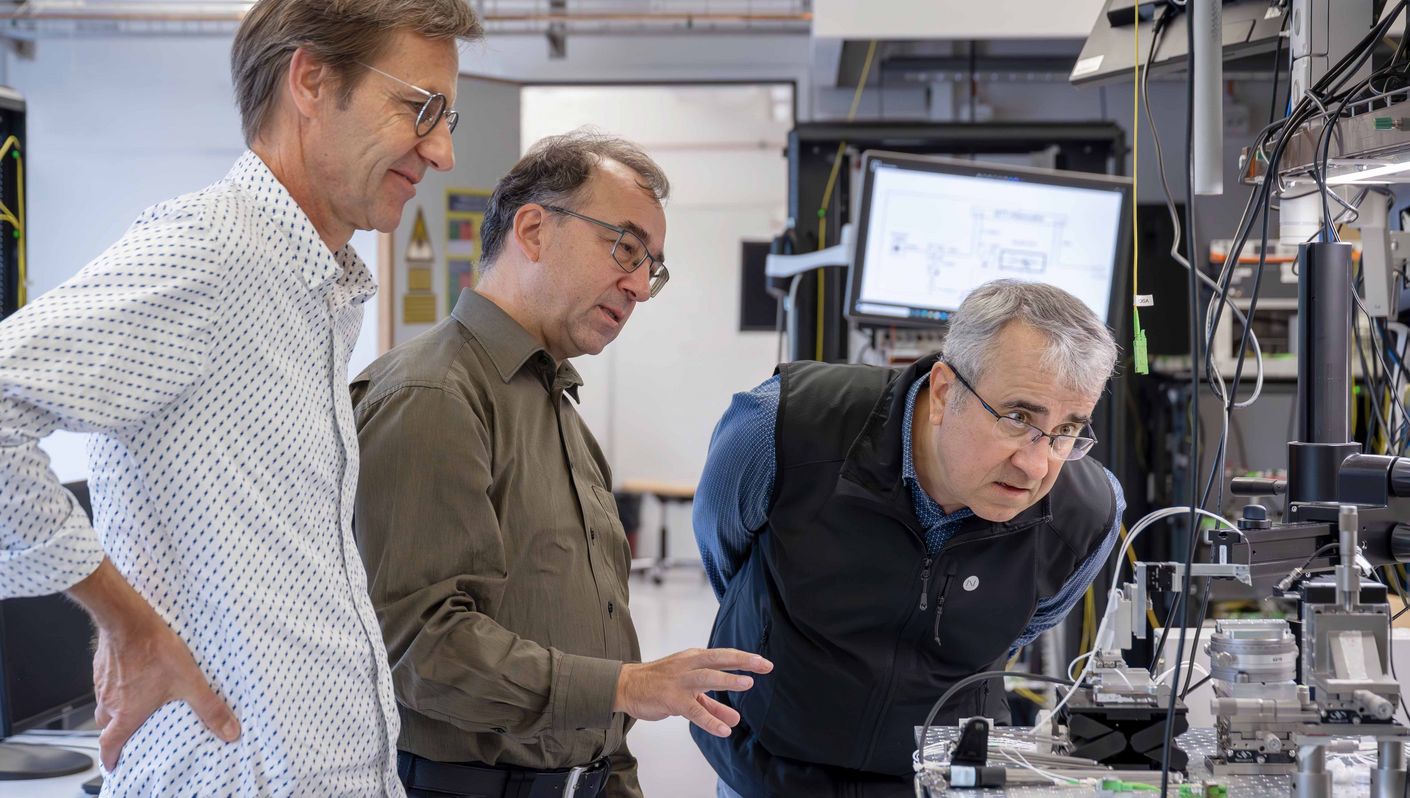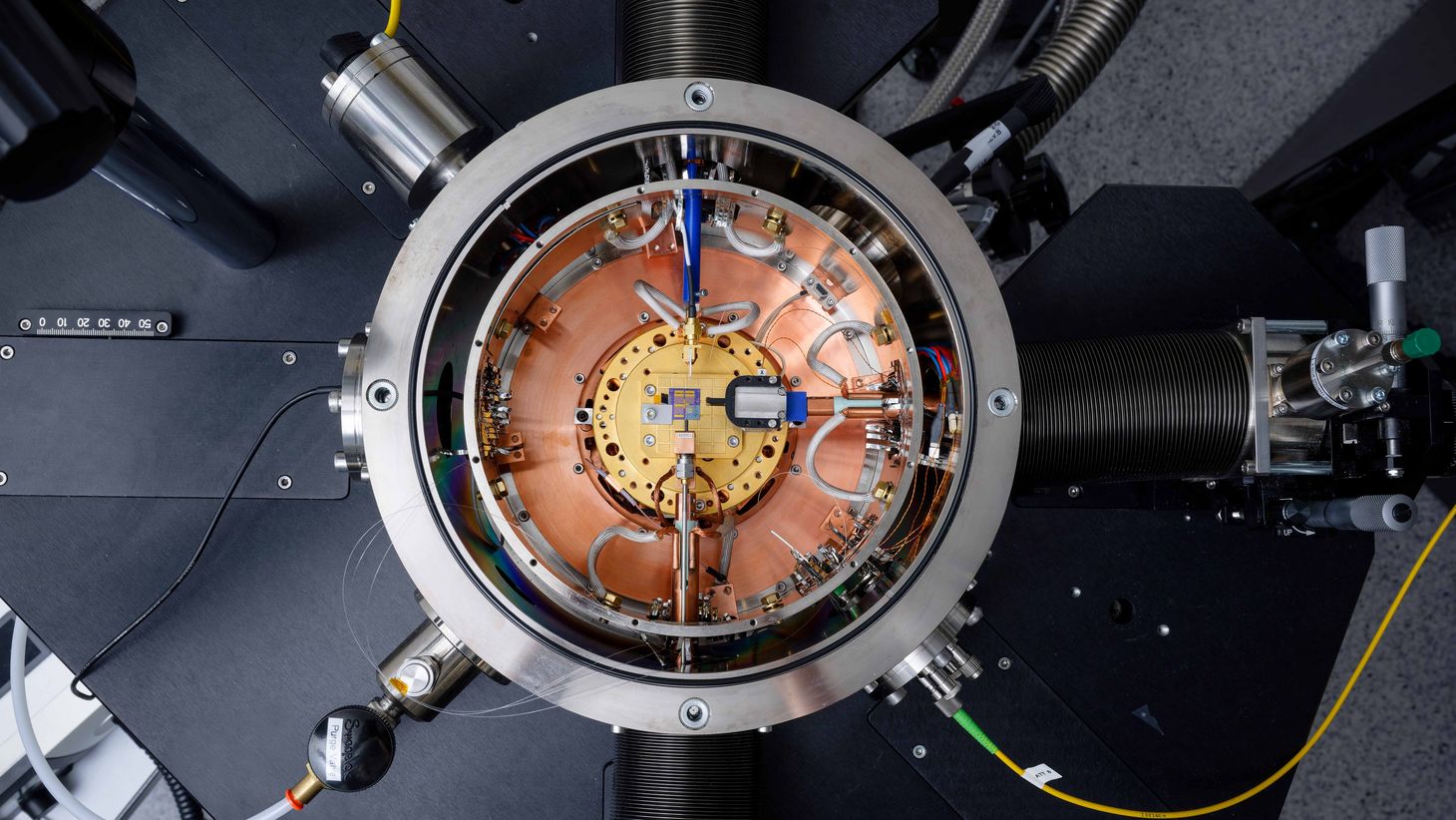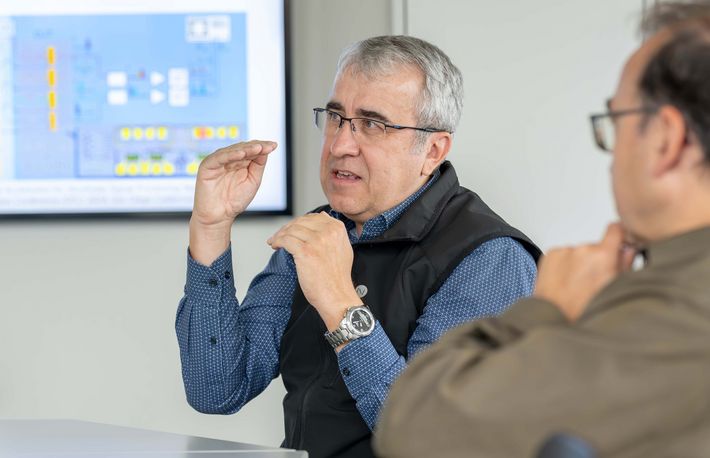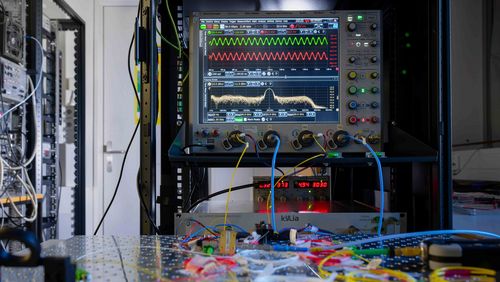
The electronics of the future
Developments made in electronic devices over the past several decades are nothing short of astonishing. And now, it’s said that fundamentally new computing technologies are in sight—an assessment shared by Jürg Leuthold, from the single-atom switch project, as well as Roman Fasel and Oliver Gröning, from the CarboQuant project. A conversation about tiny components, formidable challenges and costly microscopes.
Jürg Leuthold, Roman Fasel and Oliver Gröning, you’re all endeavouring to make electronic components even smaller and more powerful. What will our smartphones, laptops and PCs be able to do in twenty or thirty years’ time?
Jürg Leuthold: We’re on the cusp of a revolution. The CMOS semiconductor technology used in today’s laptops dates back roughly seventy years to the very first transistors made. But now we’re exploring entirely new approaches. At present, no one knows which of the solutions we’re currently investigating will prevail or exactly what the new technology will look like. But we know for certain that it will have superior capabilities.
Oliver Gröning, Roman Fasel, do you agree?
Oliver Gröning: What Jürg Leuthold says is correct. CMOS technology depends on our ability to make things smaller and more compact. Sometimes this is done via new technologies, but its basic functioning has never really changed. Now, however, we’re working on new functions, new ways of generating signals in electronic components—ultimately how these components run their calculations.
Roman Fasel: To answer your question more directly: it’s precisely because we’re on the verge of creating computing technologies that function in a fundamentally new way that I’m not convinced our laptops and smartphones will be significantly faster in twenty or thirty years. In terms of miniaturisation and performance, these new developments must first achieve what CMOS can do today. That will take time. But one way or another, the new technologies will be much more energy efficient.
What do the new approaches look like?
Leuthold: Some are in the field of quantum computing, others explore two-dimensional, novel materials. Still others—and this is what my research group and I are focusing on—deal with so-called memristive neuromorphic systems. The idea here is to imitate natural neural networks. In the past, we in electronics pushed electrons around, as it were. But in the human brain, it’s ions—electrically charged atoms or molecules—that are being pushed around. And that’s the basic concept behind our single-atom switch project: one single atom should suffice to completely change a switching state.
How does that work?
Leuthold: So, I take two metals, and I bring them together in such close proximity that only one atom fits between them. If I can render this construct conductive, I can skip five or six orders of magnitude of electrical resistance to turn a switch on and off. All I need to do is move a single atom, and have an on-off switch. That’s similar to the principle at work in our brains.
Turning to the CarboQuant project: Roman Fasel, Oliver Gröning, you’re working with quantum effects. How does that work?
Gröning: We’re trying to create molecular structures that will allow us to take advantage of quantum effects—with the aim of implementing new optical, electronic or magnetic functions. As Jürg Leuthold was saying, these are non-linear processes. Electric resistance, by contrast, is linear: if the voltage is doubled, you get twice as much electric current. But we’re not interested in that. The single-atom switch is designed to require just a tiny input to move an atom and nonetheless attain a huge effect: with a minute energy input the current increases by six orders of magnitude. Put differently, that’s a scale of one to a million. Our project has a related approach in that we define extremely precise electronic energy levels through which an electric current can flow. If we bring these levels into alignment, something happens that’s similar to the single-atom switch, although we don’t move any atoms. Rather, we create a major change in the electric current by making a minor change to the voltage.
What other effects are you studying?
Gröning: Our goal is to use a single electron charge, or a charge quantum, to make a transistor switch. We can also capitalise on magnetic moments: instead of generating an information signal with a current of one hundred million electrons, we reverse a single magnetic moment. We’re working on an entirely different energy scale because we use individual quanta—the spin in the case of a magnetic moment, or a photon in that of a quantum of light. It’s also pushing against the boundaries of what can still be described as information in physical terms. We design materials with these kinds of properties, and we’re working on integrating them into device components.
Building such tiny structures can‘t be easy.
Gröning: We wouldn’t mind working with larger objects, but it’s a simple fact that the quantum effects we use are manifested only at the atomic or molecular scale. Our materials typically measure one nanometre. It would certainly make our lives easier if they were ten nanometres.

Revolutionary single-atom switch
From espresso machines to huge mainframe computers, microchips are found in almost every electronic device we use. In recent years, researchers have succeeded in making microchips smaller and faster, but the push to get even more minuscule has now hit a wall, and the amount of energy the chips consume has become problematic. That’s why researchers at the Center for Single Atom Electronics and Photonics at ETH Zurich and at the Karlsruhe Institute of Technology (KIT) are seeking to create a completely novel microchip—one that functions at the atomic level.
Funding from the Werner Siemens Foundation
12 million Swiss francs
Project duration
2017 to 2025
Project leader
Prof. Dr Jürg Leuthold, head of the Institute of Electromagnetic Fields, ETH Zurich
> about the project
Jürg Leuthold, in your project, you’re also pushing against the boundaries of the possible in terms of size. How is this work advancing?
Leuthold: We’re getting better and better. We’ve now managed to transfer processes that occur in the brain to semiconductor technology. And in the meantime, we’ve also been able to group several components together and build the first functional blocks—the first switches that imitate the functions we see in the brain. We’ve even constructed a small network based on our switches. It’s still small, but we can already see that it will outperform conventional technologies.
How exactly does it work?
Leuthold: It’s a transmission network of a transmitter consisting of a laser and a modulator, and a receiver. There are billions of these in each and every data network. The signal transmitted is distorted when it arrives, and our job is to make the information readable. For fifty years, electronic communications theory has said we need to attach a processor that comprises various possible computing techniques—a processor that would require roughly ten thousand computing steps to rectify the signal in our small network. Now, let’s compare that system to our neural network—and transfer it to an optical neural network that requires absolutely no computing steps. The latter option beats them all.
What does that mean?
Leuthold: It means that our latest development requires around two orders of magnitude less computing power to render the signal readable. That said, there is one caveat: the result is based on components we’ve actually built and characterised, but the network itself is simulated on the basis of data. Our next step is to optimise the system and place it onto a chip. But the most important message is that the potential is huge. And I’m convinced that, in the next five to ten years, every electronic component currently used in electronic devices will have to be replaced. Because you can’t justify calculating ten thousand times more information.

Will the new components be ready so soon?
Leuthold: Some of them will see practical application much sooner than many might think. I take a positive view of the future, despite all the talk you hear in the world. For example, it’s often said that neural networks and machine learning will cause energy consumption to spiral out of control. Of course we now have more ways to apply these technologies, which does indeed increase energy consumption. But if I look just at our results, boosting energy efficiency by a factor of one thousand is very feasible. If we continue on this route, the future isn’t as bleak as some see it. Quite the contrary—there’s a lot of hope.
Are people really that pessimistic?
Gröning: Well, we’re consuming more digital services, and that uses considerably more energy. But the developments—also regarding neural networks—have huge potential. However, I don’t think it’s so much that people are pessimistic and underestimating the potential as much as I think they’re very aware of the problems that go along with these new technologies.
Leuthold: When talking about energy in general, there’s certainly a tendency towards pessimism. But if we get things right, energy consumption doesn’t necessarily need to increase.
Fasel: Perhaps it depends on how you look at it. Right now, we’re using computers to simulate neural networks. But let’s assume that, in ten years’ time, I can buy a chip with an atomic switch from you, Jürg, that itself is a neural network. Then we’d no longer need the massive computing power for the simulation. There’s potential for an incredible amount of energy savings right there. Nevertheless, we’re not there yet. In future, we most likely won’t have an energy problem but, at present, we do. As an example: not too long ago I read about a company that wants to build small nuclear power reactors to supply energy for the computer centres it uses to train AI models.
Leuthold: It will probably even out. There will be clear progress in hardware, but the advances will be neutralised by the rise in consumption.
These rebound effects are part of being human.
Fasel: That’s why we do research! And that’s why we need energy-efficient technology. But it’s not yet market ready.
Roman Fasel and Oliver Gröning, your CarboQuant project is not as close to market entry as the single-atom switch and neural networks. What progress have you recently made?
Gröning: We’re now able to design and fabricate so-called spin chains, and to turn the individual magnetic moments—the spins—on and off with precision. It’s a huge step forwards. For example, we create a chain with four spins and turn all of them on. Then we turn one of the spins off and observe how the system reacts.
Fasel: Quantum physicists work with various kinds of one-dimensional spin models, each of which has slightly different properties. Over the past two years, we’ve succeeded in realising and characterising in detail the three most fundamental models with carbon atoms—now with up to fifty spins. It’s so complex that it can no longer be calculated using conventional methods. And that’s just the beginning.
Gröning: We can think of these models as equations. Normally, researchers look for materials that would depict these equations by chance, in nature for example. But in our work, we’re looking at the equation itself, its elements and the connections between spins. Then we go to the drawing board to design a structure with these exact connections. We fabricate them and take measurements to control whether our theoretical prediction is valid. It’s my dream to use these kinds of quantum simulations to move from a one-dimensional chain to a two-dimensional network. One that has various interconnected layers. That would be an astounding leap.

“We’re working with such minuscule structures that we haven’t yet mastered the technology to the degree we’d like.”

How do you study the magnetic moments?
Gröning: We use scanning tunnelling microscopy, but our options with the instruments we currently have are very limited. That’s why we’re building a new lab for diving even deeper into quantum magnetism and further developing the field. In this lab, we’re setting up two new scanning tunnelling microscopes that work with radio frequency and a strong magnetic field, enabling us to analyse and measure magnetic properties in time resolution on the atomic scale.
Fasel: We needed completely new labs for these instruments. It involved a huge investment. In terms of resources, it’s probably the biggest development we’re working on at the moment.
Were the microscopes custom-made according to your specifications?
Gröning: Yes. Complex and expensive equipment like this can’t be ordered from a catalogue. The basic system is there, but we had to adapt it to our own specific needs—we want to synthesise our materials in a vacuum, for example. From the design phase to final delivery, each of the microscopes took more than two years to construct.
Fasel: And the most important point is that we need people capable of operating this kind of equipment. There aren’t too many of these specialists—maybe just a few research groups worldwide have the necessary experience. We’re fortunate in that we found a first-rate researcher: Yujeong Bae from South Korea.
What else do you need to make these quantum effects applicable?
Gröning: We have to place our elements on a chip and connect them with electrical contacts. But we encounter an uncertainty factor in this transfer—we don’t know exactly where our spin chains come to rest. That’s why we also can’t say whether a specific property stems from our system, from the specific type of contact or from the interaction with the component. We have to find a solution here.
Fasel: We’re developing a materials platform that we hope will eventually be available for quantum applications. There’s much work to be done here, as each material has to be integrated, linked and addressed. On top of that, there’s all the hierarchical systems. As big as the WSS project is, and as much as we’re doing, it’s important to put it in the proper perspective.
Jürg Leuthold, your project is at a more advanced stage.
Leuthold: We have individual components that function. Now, our job is to bring them all together. However, we’re working with such minuscule structures that we haven’t yet mastered the technology to the degree we’d like. Conventional electron-beam lithography can fabricate structures of down to around ten nanometres. Now, we’re endeavouring to boost precision by using atomic force lithography. Our biggest challenge is the precision placement of individual atoms.
Is the challenge similar to placing spin chains?
Gröning: That’s right. It’s a fundamental problem in our work. Miniaturisation is approaching the atomic scale, and a silicon semiconductor measuring five to ten nanometres contains tens of thousands of atoms. But in both our projects, we’re dealing with single atoms. A choir is a good analogy: if two of ten thousand singers hit the wrong note, it’s no big deal. But when one singer in a trio is off-key, you’re going to hear it.

CarboQuant
The CarboQuant team at the Swiss Federal Laboratories for Materials Science and Technology (Empa) in Dübendorf, Switzerland, is aiming to develop extremely small quantum electronic components that will ideally function at room temperature, making them suitable for use in everyday devices.
Funding from the Werner Siemens Foundation
15 million Swiss francs
Project duration
2022 to 2032
Project leaders
Prof. Dr Roman Fasel, head of nanotech@surfaces Laboratory, Empa, Dübendorf
Dr Oliver Gröning, deputy head of nanotech@surfaces Laboratory, Empa, Dübendorf
> about the project
Can your two groups learn from each other?
Leuthold: We’re already benefiting from the synergies. Some of my team work at Empa because they have the equipment they need there. And our approaches complement each other. As I said earlier, it’s unclear which technology will win the race. And maybe we’ll need all of them: plasmonic particles, memristors and quantum components. I’m convinced that the computers of the future will take the best from every new technology.
Gröning: The areas that overlap in our project are concrete. Professor Mathieu Luisier, who researches in the single-atom switch project, is an absolute expert in the theoretical calculation of electron currents in such small systems. This aspect is important in our project, too, and we’re also working with him. Our projects are more closely related than may seem apparent at first sight.
Is the physical proximity an advantage for this collaboration?
Fasel: Certainly. We use some of the same infrastructure. Jürg Leuthold needs a clean room, we need a clean room. Not every lab houses equipment for structuring or etching materials. That’s why Zurich is a good research location.
Leuthold: My vision is to create a new clean room for electronics and nanotechnology on the site of the former Dübendorf airfield. The more we move into the atomic scale, the more expensive the machines. If we—ETH Zurich, the University of Zurich, PSI, Empa and private companies—work together, the Zurich region will become a real powerhouse in the field.
Can you say what new applications will be possible if you succeed in miniaturising electronic components to the nth degree?
Gröning: It’s really difficult to predict what new needs will arise. However, disruptive concepts like quantum computing can be used to calculate things like complex biological systems. It would make quantum chemistry or highly interconnected climate simulations possible.
Leuthold: I’ve already seen the potential in some smaller outcomes. For example at Sleepiz, one of our institute’s start-ups, where a device was developed that uses electromagnetic waves to monitor the body during sleep—tracking information like how the chest moves and the heart beats. By processing the data gathered, it can send a warning signal two weeks before a heart attack is likely to happen. The device was created using findings from our research into optical communication systems.
That’s something you wouldn’t expect.
Leuthold: True. And you don’t even need a giant supercomputer for it. Our developments are simple, but spectacular.
Gröning: That’s a very good point. New technologies often run in the background, and we use them without really noticing them. Every day, I commute from Solothurn to Zurich with two thousand other people, maybe five hundred of whom are watching a film in real time on their smartphones. Every now and then, it would be good to stop and think about the technical developments of the past ten years that have enabled this kind of data transmission.










